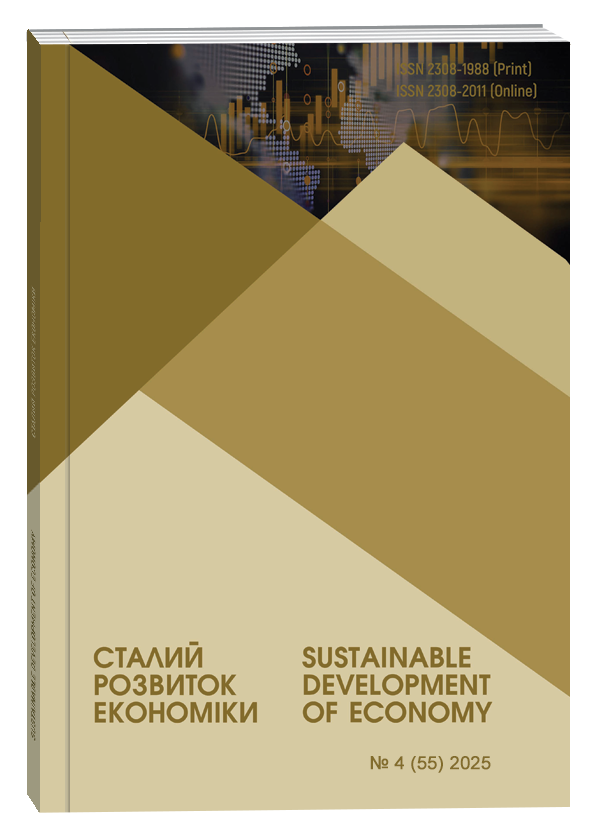TAX INSTRUMENTS IN ENSURING CONSTANT REPRODUCTION OF THE ECONOMIC PROCESSES ENTROPY PREMISES MINIMIZATION
Abstract
The article is devoted to the study of effective instruments for ensuring constant reproduction of the economic process’s entropy premises minimization. The paper examines the essence, content, and various views on the entropy interpretation in economic theory. The main prerequisites for the entropy emergence in the economy are determined. The necessity to implement an economic model focused on environmental conservation and ensuring of the constant reproduction of the economic processes entropy premises minimization is substantiated. The process of functioning of an organization as an open system is examined. Attention is focused on the irreversible energy and resources dissipation in economic processes, which leads to the need to increase input resources to maintain the previous level of production. It is determined that waste generated as a result of the economic activities of business entities is a physical manifestation of entropy in the economy. The essence and basic principles of the circular economic model are revealed. It is noted that waste recycling is a key element of this economic model. It is determined that the economic processes entropy can be minimized by a circular economic model implementation, since this model is focused on preventing the inevitable loss of valuable resources and reducing the need for primary raw materials. The main economic instruments for incentivizing of the transition from a linear model based on use and disposal to a circular economy are studied. It is determined that the most effective economic instrument of state environmental policy that stimulates economic entities to minimize the negative impact on the environment and fosters the transition to a circular economy are environmental taxes. The main categories of current environmental taxes in EU countries are considered. It is established that the main part in the structure of tax revenues from eco-tax payments in EU countries forms energy taxes. The main methods of waste management system in EU countries are analyzed. It is determined that the use of such economic instruments as environmental taxes has allowed European countries to build a powerful waste management industry and significantly reduce a landfilling. An analysis of the effectiveness of the main tax instruments aimed at stimulating the formation of a circular economic model has been conducted.
References
Mayumi K. The Origins of Ecological Economics: The Bioeconomics of Georgescu-Roegen. L., N.-Y. : Routledge, 2001. 161 p.
Cockshott P., Wright I. Entropy and econophysics. The European Physical Journal Special Topics. 2016. Vol. 225. P. 3091–3104
Янковський Н.А., Макогон Ю.В., Рябчин А.М. Інноваційні та класичні теорії катастроф та еконотичних криз: монографія / за ред. Макогона Ю.В. Донецьк: ДонНУ, 2009. 331 с.
Chalenko A.Y. Self-organization, enthropy in nature and economics. Наука та інновації. 2013. Т. 9. № 4. P. 13-24.
Шарапов О.Д., Дербенцев В.Д., Семьонов Д.Є. Економічна кібернетика: навчальний посібник. Київ : КНЕУ, 2004. С. 231.
Беркман Л.Н., Комарова Л.О., Чумак О.І. Основні поняття та теореми теорії інформації: навчальний посібник. Київ: Державний університет телекомунікацій, 2015. С. 91.
Лійв Е.Х. Інфодинаміка. Узагальнена ентропія та негентропія. Таллінн, 1998. С. 200.
Cropper W. H. The Road to Entropy Rudolf Clausius. Great Physicists: The Life and Times of Leading Physicists from Galileo to Hawking. Oxford University Press, 2004. P. 93 – 105.
Clausius, R. The Mechanical Theory of Heat – with its Applications to the Steam Engine and to Physical Properties of Bodies. London: John van Voorst, 1867. P. 376.
Бусел В.Т. Великий тлумачний словник сучасної української мови. Київ, Ірпінь: ВТФ ‘Перун’, 2003.
Georgesçu-Roegen N. The entropy law and the econom-ic process. Cambridge: Harvard University Press, 1971. 457.
Бухаріна Л., Бірюков Т., Павлов О. (2025) Механізми переходу національної економіки на циркулярну модель розвитку в умовах інтеграції України в європейський економічний простір: податковий та регуляторний аспекти, Менеджмент та підприємництво: тренди розвитку. 2025. Вип. 2(32). С. 10 – 33. DOI: https://doi.org/10.26661/2522-1566/2025-2/32-01.
Шебанін В.С., Решетілов Г.О. Циркулярна економіка регіону: теоретичний аспект. Вісник аграрної науки Причорномор’я. 2021. Вип. 4. С. 4–13. DOI: https://doi.org/10.31521/2313-092X/2021-4 (112)
Сергієнко-Бердюкова Л.В. Передумови формування та впровадження концепції циркулярної економіки. Проблеми, теорії та методології бухгалтерського обліку, контролю і аналізу. 2015. Вип. 3. С. 327 – 350. DOI: https://doi.org/10.26642/pbo-2015-3(33)-327-352
Official page of United Nations Development Programme. Circular economy action plan (CEAP). URL: https://www.undp.org/sites/g/files/zskgke326/files/2022-08/2%20FINAL_Tree_Circular_economy_action_plan_297x210mm_4%2B4_web_180822.pdf (дата звернення: 27.07.2025)
Official web-page of global impact organisation ‘Circle Economy Foundation’. We need an economic system that ensures the planet and all living beings can thrive. URL: https://www.circle-economy.com (дата звернення: 27.07.2025).
Official page of United Nations Development Programme. Circular economy action plan (CEAP). Available at: https://www.undp.org/sites/g/files/zskgke326/files/2022-08/2%20FINAL_Tree_Circular_economy_action_plan_297x210mm_4%2B4_web_180822.pdf (дата звернення: 27.07.2025)
Official page of United Nations Development Programme. Circular economy action plan (CEAP). Available at: https://www.undp.org/sites/g/files/zskgke326/files/2022-08/2%20FINAL_Tree_Circular_economy_action_plan_297x210mm_4%2B4_web_180822.pdf (дата звернення: 27.07.2025).
Податковий кодекс України: Закон України від 06.10.2022 р. № 2654-IХ. Відомості Верховної Ради України. 2011. № 13-17. Ст. 112. URL: https://tax.gov.ua/nk/rozdil-viii--ekologichniy-poda/ (дата звернення: 27.07.2025).
Eurostat. Environmental taxes by economic activity. URL: https://ec.europa.eu/eurostat/databrowser/view/env_ac_taxind2/default/table?lang=en (дата звернення: 27.07.2025).
Eurostat. Treatment of waste by waste category, hazardousness and waste management operations. URL: https://ec.europa.eu/eurostat/databrowser/view/env_wastrt/default/table?lang=en (дата звернення: 30.07.2025).
Булавинець В. М. Екологічне оподаткування як інструмент ‘зелених’ фінансів Ефективна економіка. 2020. Вип. 12. URL: http://nbuv.gov.ua/UJRN/efek_2020_12_68 (дата звернення: 30.07.2025).
Mayumi K. (2001). The Origins of Ecological Economics: The Bioeconomics of Georgescu-Roegen. L., N.-Y. : Routledge, 161 p.
Cockshott P., Wright I. (2016). Entropy and econophysics. The European Physical Journal Special Topics, vol. 225, pp. 3091–3104.
Yankovsky N.A., Makogon Y.V., Ryabchyn A.M. (2009). Innovatsiyni ta klasychni teoriyi katastrof ta ekonomichnykh kryz: monohrafiya [Innovative and classical theories of disasters and economic crises: monograph]. Donetsk: DonNU, 331 p. (in Ukrainian)
Chalenko O. YU. (2013). Samoorhanizatsiya, entropiya v pryrodi ta ekonomitsi [Self-organization, entropy in nature and economics]. Nauka ta innovatsiyi, vol. 9, no. 4, pp. 13-24. (in Ukrainian)
Sharapov O.D., Derbentsev V.D., Semʹonov D.YE. (2004). Ekonomichna kibernetyka: navchalʹnyy posibnyk [Economic Cybernetics: Textbook]. Kyiv: KNEU, p. 231. (in Ukrainian)
Berkman L.N., Komarova L.O., Chumak O.I. (2015) Osnovni ponyattya ta teoremy teoriyi informatsiyi [Basic Concepts and Theorems of Information Theory Kyiv: Derzhavnyi universytet telekomunikatsii, p. 91. (in Ukrainian)
Liyv E.KH. (1998). Infodynamika. Uzahalʹnena entropiya ta nehentropiya [Generalized entropy and negentropy]. Tallinn, p. 200. (in Ukrainian)
Cropper W.H. (2004). ‘The Road to Entropy Rudolf Clausius’. Great Physicists: The Life and Times of Leading Physicists from Galileo to Hawking. Oxford University Press, pp. 93–105.
Clausius R. (1867). The Mechanical Theory of Heat – with its Applications to the Steam Engine and to Physical Properties of Bodies. London: John van Voorst, p. 376.
Busel V.T. (2003). Velykyy tlumachnyy slovnyk suchasnoyi ukrayinsʹkoyi movy [Large Explanatory Dictionary of the Modern Ukrainian Language]. Kyiv, Irpin: VTF ‘Perun’.
Georgesçu-Roegen N. (1971) The entropy law and the econom-ic process. Cambridge: Harvard University Press, p. 457.
Bukharina L., Biriukov T., Pavlov O. (2025). Mekhanizmy perekhodu natsionalʹnoyi ekonomiky na tsyrkulyarnu modelʹ rozvytku v umovakh intehratsiyi Ukrayiny v yevropeysʹkyy ekonomichnyy prostir: podatkovyy ta rehulyatornyy aspekty [Mechanisms of the national economy transition to a circular model of development in the conditions of Ukraine’s integration into the European economic area: tax and regulatory aspects]. Menedzhment ta pidpryiemnytstvo: trendy rozvytku, vol. 2(32), pp. 10 – 33. DOI: https://doi.org/10.26661/2522-1566/2025-2/32-01. (in Ukrainian)
Shebanin V.S., Reshetilov H.O. (2021) Tsyrkulyarna ekonomika rehionu: teoretychnyy aspekt [Circular economy of the region: theoretical aspect]. Visnyk ahrarnoyi nauky Prychornomorya, vol. 4., pp. 4–13. DOI: https://doi.org/10.31521/2313-092X/2021-4 (112) (in Ukrainian)
Serhiyenko-Berdyukova L.V. (2015) Peredumovy formuvannya ta vprovadzhennya kontseptsiyi tsyrkulyarnoyi ekonomiky [Prerequisites for the formation and implementation of the concept of a circular economy]. Problemy, teoriyi ta metodolohiyi bukhhaltersʹkoho obliku, kontrolyu i analizu, vol. 3. pp. 327 – 350. DOI: https://doi.org/10.26642/pbo-2015-3(33)-327-352 (in Ukrainian)
Official page of United Nations Development Programme. Circular economy action plan (CEAP). Available at: https://www.undp.org/sites/g/files/zskgke326/files/2022-08/2%20FINAL_Tree_Circular_economy_action_plan_297x210mm_4%2B4_web_180822.pdf
Official web-page of global impact organisation ‘Circle Economy Foundation’. We need an economic system that ensures the planet and all living beings can thrive. Available at: https://www.circle-economy.com (accessed July 27, 2022)
Official page of United Nations Development Programme. Circular economy action plan (CEAP). Available at: https://www.undp.org/sites/g/files/zskgke326/files/2022-08/2%20FINAL_Tree_Circular_economy_action_plan_297x210mm_4%2B4_web_180822.pdf
Official page of United Nations Development Programme. Circular economy action plan (CEAP). Available at: https://www.undp.org/sites/g/files/zskgke326/files/2022-08/2%20FINAL_Tree_Circular_economy_action_plan_297x210mm_4%2B4_web_180822.pdf
Podatkovyi kodeks Ukrainy: Zakon Ukrainy vid 06.10.2022 r. № 2654-IKh. Vidomosti Verkhovnoi Rady Ukrainy. 2011. № 13-17. St. 112 [Tax Code of Ukraine: Law of Ukraine dated 06.10.2022 No. 2654-IX. Bulletin of the Verkhovna Rada of Ukraine. 2011. No. 13-17. Art. 112]. Available at: https://tax.gov.ua/nk/rozdil-viii--ekologichniy-poda/ (in Ukrainian)
Eurostat. Environmental taxes by economic activity. Available at: https://ec.europa.eu/eurostat/databrowser/view/env_ac_taxind2/default/table?lang=en
Eurostat. Treatment of waste by waste category, hazardousness and waste management operations. Available at: https://ec.europa.eu/eurostat/databrowser/view/env_wastrt/default/table?lang=en
Bulavynets V. M. (2020) Ekolohichne opodatkuvannya yak instrument "zelenykh" finansiv [Environmental taxation as a tool of "green" finance]. Efektyvna ekonomika, vol. 12. Available at: http://www.economy.nayka.com.ua/pdf/12_2020/118.pdf (in Ukrainian)


